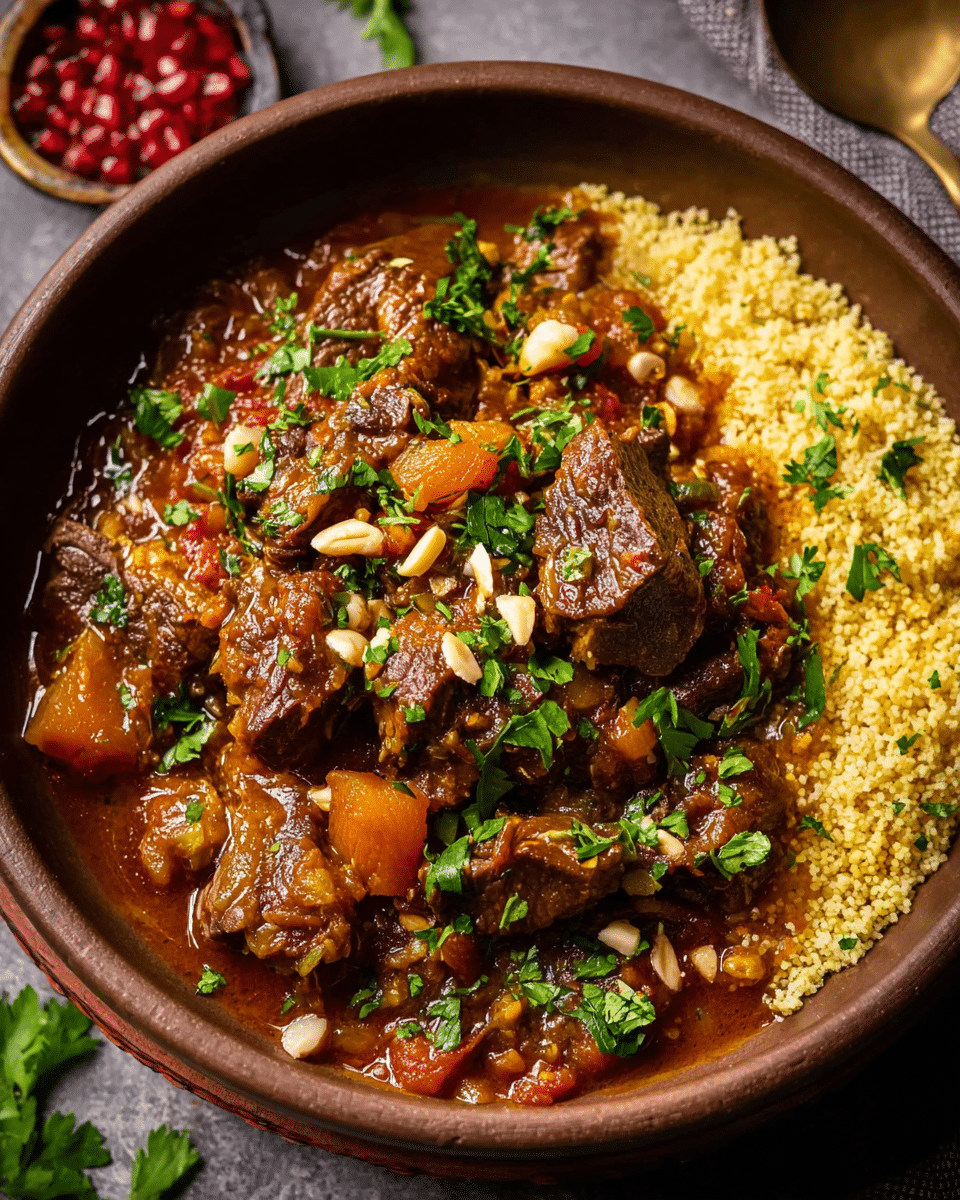Lamb Tagine is a mouthwatering Moroccan dish, perfect for those who love rich, spiced flavors. The lamb, usually lamb shoulder, is slow-cooked with a blend of spices, creating a tender, fall-apart texture and a flavorful, thick sauce. The combination of dried apricots, slivered almonds, and fresh lemon zest adds sweetness and freshness to balance the richness of the lamb. It’s traditionally served over couscous, making it a complete and satisfying meal. This dish is best cooked in the oven to allow the sauce to reduce and the lamb to become perfectly tender.
Full recipe:
Ingredients:
For the Tagine:
-
1.6 kg (3.2 lbs) boneless lamb shoulder (trimmed fat, cut into 3.5 cm/1.5″ cubes) or 1 kg (2 lbs) lamb stew meat, cut into 3.5 cm/1.5″ cubes
-
1 tsp cooking or kosher salt
-
1/2 tsp black pepper
-
3 tbsp canola oil
-
3 cloves garlic, finely minced
-
2 brown onions, diced (1 cm/0.3″)
-
1 1/2 tbsp tomato paste
-
2 tsp grated ginger
-
2 cinnamon sticks
-
2 1/2 cups chicken stock (low sodium)
-
1 cup dried apricots (whole)
-
2 – 3 tsp lemon zest (or preserved lemon if preferred)
For the Ras el Hanout Spice Mix:
-
1 tbsp ground coriander
-
1 tbsp ground cumin
-
2 tsp ground cardamom
-
2 tsp turmeric powder
-
1 1/2 tsp fennel powder
-
1 tsp cayenne pepper (optional, for less heat)
-
1/4 tsp ground cloves
-
1/4 tsp ground ginger
-
1/2 tsp kosher salt
For Serving:
-
1/2 cup slivered almonds (toasted)
-
1/2 cup chopped coriander/cilantro
-
Plain couscous (1 1/2 batches)
Directions:
- Prepare the Spice Mix:
Combine all the spices (coriander, cumin, cardamom, turmeric, fennel, cayenne, cloves, ginger, and salt) in a small bowl and set aside.
- Brown the Lamb:
Toss lamb pieces with salt and pepper. Heat oil in a large oven-proof Dutch oven over high heat. Brown the lamb in batches (do not overcrowd the pot). Each batch should be browned for about 3 minutes. Once browned, set the lamb aside.
- Cook the Aromatics:
In the same pot, lower the heat to medium-high. Add the diced onions and garlic. Cook for 3 minutes until softened.
Stir in tomato paste, grated ginger, cinnamon sticks, and the spice mix. Cook for 1 1/2 minutes, stirring constantly to toast the spices.
- Add Braising Liquid:
Add chicken stock and water. Stir to combine, then return the browned lamb to the pot. Bring everything to a simmer.
- Slow Cook in the Oven:
Cover the pot with a lid and place it in a preheated oven at 180°F/350°F (160°C fan-forced). Cook for 45 minutes.
- Add Apricots:
After the first 45 minutes, stir in the dried apricots. Cover the pot again and cook for another hour, or until the lamb is fork-tender and the sauce has thickened.
- Finish the Dish:
Once the lamb is tender, stir in fresh lemon zest to add brightness. Serve the tagine over plain couscous, and garnish with toasted slivered almonds and fresh coriander.
What is Lamb Tagine?
The term “tagine” refers to both the type of cooking vessel used in Moroccan cuisine and the dish that is cooked within it. The tagine pot is a clay or ceramic vessel with a unique cone-shaped lid that helps to circulate steam, making it perfect for slow cooking. The dish itself is a stew that combines meats, vegetables, and spices, simmered together to create a flavorful and tender meal.
Lamb Tagine specifically refers to a stew made with lamb, which is known for its rich and gamey flavor. The slow-cooking process allows the meat to become incredibly tender, while the spices meld into the sauce, creating a depth of flavor that is unmatched. Typically, lamb shoulder is the preferred cut for this dish, as it is a tough cut that becomes wonderfully tender when braised over a long period.
The Role of Spices in Lamb Tagine
One of the most defining features of Lamb Tagine is its bold and complex spice blend. The signature seasoning for this dish is ras el hanout, a Moroccan spice mix that translates to “head of the shop,” meaning it contains the best spices a spice merchant has to offer. This mix typically includes a combination of cumin, coriander, cinnamon, turmeric, cardamom, fennel, and sometimes saffron or rose petals. These spices not only add warmth and depth to the dish but also help to balance the richness of the lamb.
The spices used in Lamb Tagine are aromatic and often have both savory and sweet elements. Cinnamon sticks, for example, are often used in tagines to impart a mild sweetness, while ginger adds a zesty, fresh note. The use of dried fruit, such as apricots, raisins, or dates, also introduces a touch of sweetness, which contrasts beautifully with the savory lamb.
The Slow Cooking Process
One of the keys to a perfect Lamb Tagine is the slow cooking process. This method allows the flavors to develop gradually, resulting in tender meat and a thick, flavorful sauce. The lamb is usually browned first to develop a rich, caramelized crust, which enhances the overall flavor of the dish. After the lamb is browned, aromatics such as garlic, onion, and ginger are sautéed to create a flavor base.
Once the aromatics are ready, the spices and liquid—usually chicken stock—are added to the pot. The dish is then transferred to the oven, where it simmers slowly for a couple of hours. The long cooking time allows the lamb to absorb the spices and become melt-in-your-mouth tender, while the sauce reduces and thickens, concentrating all the flavors. This is why it is essential to use the right cut of meat, as tougher cuts like lamb shoulder will break down into tender, juicy morsels that melt in the sauce.
Serving Lamb Tagine
Lamb Tagine is traditionally served with couscous, a steamed wheat dish that pairs perfectly with the rich, spiced sauce. The couscous acts as a neutral base, soaking up the flavorful juices from the lamb and spices. Some variations may include additional accompaniments, such as flatbread or vegetables, but couscous is by far the most common.
To finish off the dish, toasted slivered almonds and fresh herbs like cilantro or parsley are sprinkled over the top. The almonds provide a delightful crunch that contrasts with the tender lamb, while the fresh herbs add a burst of color and freshness. A final touch of lemon zest or preserved lemon can add a bright, citrusy note that cuts through the richness of the dish.
Why the Oven Works Best for Lamb Tagine
While it is possible to cook Lamb Tagine on the stovetop or in a slow cooker, the oven is the ideal method for achieving the best results. The oven provides consistent, even heat that allows the sauce to reduce properly, concentrating all the flavors. The slow, dry heat of the oven also helps to caramelize the lamb, creating a deeper, more complex flavor profile.
On the stovetop, you would need to stir the dish regularly to prevent the sauce from burning or sticking to the bottom of the pot. This can be difficult when cooking a dish like Lamb Tagine, where the sauce is thick and the meat is delicate. Similarly, while a slow cooker can also be used, it doesn’t allow for the sauce to reduce and thicken in the same way the oven does.
For these reasons, cooking Lamb Tagine in the oven ensures a rich, flavorful sauce and tender meat that is not easily achieved through other methods.
Variations of Lamb Tagine
While Lamb Tagine is a beloved Moroccan classic, there are many variations of this dish that reflect different regional influences and personal preferences. Here are a few popular alternatives:
-
Lamb Tagine with Olives: Some variations of Lamb Tagine include green olives, which provide a salty, briny contrast to the sweetness of the dried fruit and the richness of the lamb. The olives add depth and complexity to the sauce and are often paired with preserved lemons for an extra burst of tang.
-
Lamb Tagine with Vegetables: Although the traditional version of Lamb Tagine is focused on meat, some recipes incorporate a variety of vegetables, such as carrots, sweet potatoes, or eggplant. These vegetables absorb the spices and contribute to the overall flavor of the dish.
-
Lamb Tagine with Dates: In some regions, dates are used in place of apricots. The dates lend a rich, caramel-like sweetness to the dish, enhancing the complexity of the sauce.
-
Spicy Lamb Tagine: For those who enjoy a little heat, the amount of cayenne pepper in the ras el hanout can be increased to create a spicier version of Lamb Tagine. This variation adds an extra layer of warmth and complexity to the dish.
Tips for the Best Lamb Tagine
-
Use the Right Cut of Lamb: Lamb shoulder is the best cut for Lamb Tagine because it is marbled with fat, which helps to keep the meat moist and tender during slow cooking. Avoid lean cuts like lamb leg, as they may dry out during the cooking process.
-
Don’t Rush the Cooking Process: Slow cooking is essential for developing the rich, deep flavors in Lamb Tagine. Be patient and allow the dish to cook for the recommended time to ensure the lamb becomes perfectly tender and the sauce thickens to the right consistency.
-
Adjust the Spice Mix to Your Liking: The ras el hanout spice mix can be adjusted based on your personal preferences. Feel free to add more cinnamon for sweetness or increase the cayenne pepper for heat. The beauty of this dish lies in the flexibility of the spice blend.
-
Add Fruit at the Right Time: Dried fruit, like apricots or dates, should be added midway through the cooking process to prevent them from becoming too soft. The fruit should retain its shape and provide bursts of sweetness throughout the dish.
-
Use Fresh Herbs and Nuts for Garnish: To add contrast and freshness to the dish, garnish with freshly chopped cilantro or parsley, and top with toasted almonds for a satisfying crunch.
Conclusion
Lamb Tagine is a stunning Moroccan dish that showcases the beauty of slow-cooked flavors and aromatic spices. Its rich, tender lamb and complex sauce make it a standout meal for any occasion. Whether you stick to the traditional recipe or try one of the many variations, Lamb Tagine is sure to impress with its depth of flavor and its ability to transport you to the heart of Morocco. By following a few simple tips and techniques, you can recreate this flavorful dish in your own kitchen and enjoy the warmth and richness that Moroccan cuisine has to offer.






